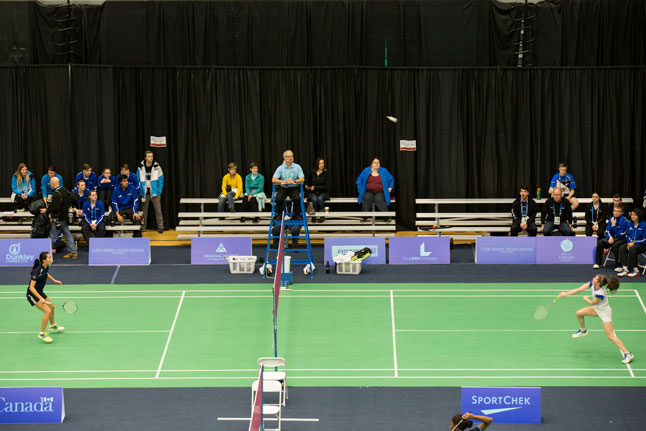
If you’re reading this post, you might be wondering what the difference between Nanoray and Nanoflare rackets is. While there are certain similarities between these racket models, such as an isometric head shape and a head-light design, they also integrate unique technology that distinguish them different. In this blog post, we’ll explain the technologies that make them different.

Let’s jump in to the Nanoflare Series.
The Nanoflare line blends the agility and speed of head-light rackets with the power of head-heavy rackets.
The NANOFLARE racket series is a revolutionary line of badminton rackets that combines lightning-fast speed and excellent repulsion for unrivalled performance on the court. NANOFLARE is the first head-light racket that combines improved shuttle acceleration and point-winning power in a single streamlined package, thanks to its revolutionary design and advanced technology. The SONIC FLARE SYSTEM, which blends TORAYCA® M40X, a brand-new carbon fiber, with Super High Modulus Graphite to offer unrivalled stability, speed, and repulsion capability, is at the heart of this cutting-edge technology. NANOFLARE was developed from the bottom up to give players the edge they need to take their game to the next level, with pinpoint accuracy and unrivalled agility.

Nanoflare rackets use the Sonic Flare system, which consists of TORAYCA M40X and Super High Modulus Graphite to provide unrivalled power & stability for maximum shuttle acceleration. The HM Graphite is found at the top of the frame, while the TORAYCA M40x is found at the bottom. This creates improved repulsion performance while increasing the stability of the frame.
The TORAYCA M40X is a new series of carbon fibers made by Toray. They are stronger and more rigid than traditional carbon fibers as Toray used technology to control the graphite crystal structure in on a micro level. This made the fibers about 30% stronger, while still keeping them just as rigid as traditional carbon fibers.
Super high modulus graphite is made from carbon fibers that have been tightly woven together and saturated with resin to form a strong composite material. The fibers used in super high modulus graphite are much thinner and stronger than those used in standard graphite, which allows for greater control over the stiffness and strength of the final product.
NANOMETRIC improves the bonding strength between the carbon fibres enabling Yonex to take racquet shaft construction to another level. By reducing the amount of carbon in the shaft to make it 60%* thinner than a conventional racquet whilst retaining stiffness, YONEX has created a revolutionary lightweight racquet with lightening head speed and control.
This technology causes the frame of the rackets to be 11.5% more aerodynamic from all angles, resulting in a faster swing speed. This is achieved by streamlining the ultra-thin frame.
The head-light construction of these rackets enables for lightning-fast swing speeds and superb control. The Nanoray series has never been quicker or more powerful, due to a variety of revolutionary designs and technology.
While not all Nanoray rackets have the same attributes, they are all designed to provide players an advantage on the court. Some versions have a slimmer frame and a stronger shaft for enhanced power and control, while others use sophisticated materials such as Nanometric or X-Fullerene for increased repulsion and stability.

X fullerene is a sort of molecule with a football-like structure made up of four radial ribs that connect carbon atoms. The X-Fullerene is mixed into the epoxy used to join the carbon fibers in the racket frame.
The binding force between the carbon fibers is boosted tenfold by adding X-Fullerene to the resin. This results in a cross-link architecture that significantly strengthens and stabilizes the racket frame. As a result, the racket has 5% more repulsion power, allowing players to strike the shuttlecock with greater speed and power. The enhanced stability also allows players to better control their strokes and improve their accuracy, resulting in a 15% increase in stability.
With the Snap Back Zone (SBZ), the rackets have thicker, stronger upper and lower frame ends. The centre of the frame is narrower and made of a more elastic and powerful material, causing the racket to bend when in contact with the shuttle. After flexing, the racket returns to its natural position, where the frame folds over the shuttle, sending it back to the opposing end of the court at a steeper downward angle.
While the thicker sides of the frame create more repulsion, the thinner top of the frame minimizes air resistance for a faster swing. This allows players to control the pace of the rally with a quick competitive advantage.
To summarize, while the Yonex Nanoray and Nanoflare racket series have certain similarities, they also have distinct features and technology that can help players enhance their performance on the court. Whether you’re searching for a racket with more power and control, or one with lightning-fast speed and maneuverability, Yonex has a racket for you.
Welovebadminton.co is a website and resource for everything badminton related. Our focus is news, badminton information and reviews on badminton equipment. Looking for the best rackets, shuttlecocks, nets and training equipment? Check out our reviews and where you can buy them!

10 Best Badminton Players in the World This blog will look at the 10 best badminton players in the world, highlighting what makes them unique in their

Who Is The Father Of Badminton? A boy who once dreamed of being the number one player in badminton became more than a milestone in

Racket sports, such as badminton, tennis, squash, and pickleball, can provide numerous health benefits. Here are 6 ways that playing racket sports can benefit your health:

Getting Started In Badminton – Badminton Equipment and Gear This article will go through the important badminton equipment and gear that beginners should consider purchasing

Badminton at the 2024 Paris Olympics What can we expect from Badminton at the 2024 Paris Olympics? Badminton debuted as a demonstration sport at the 1972 Munich

Top 5 Female Badminton Players Top 5 female badminton players 2023. With every passing day, Badminton is becoming an increasingly popular sport – with the
Copyright © 2022 Welovebadminton- All Rights Reserved